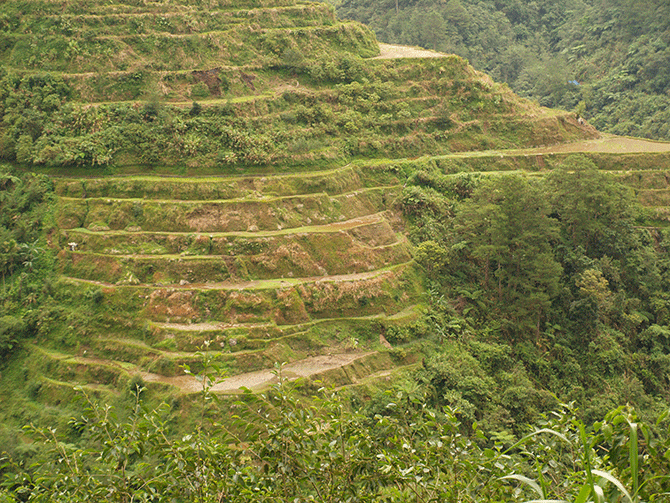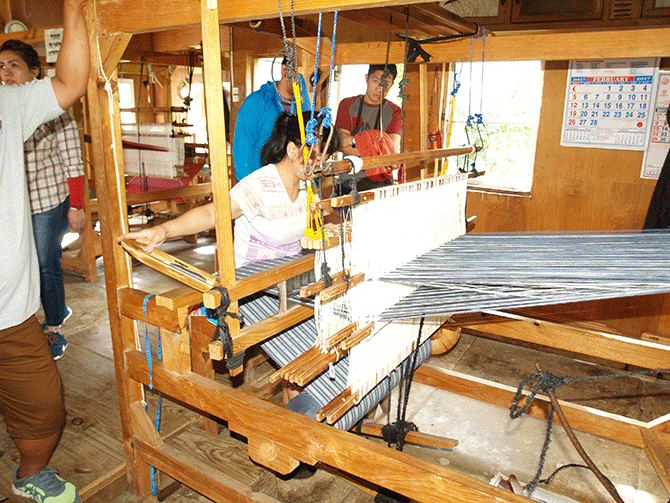
Last weekend I was 1,500 meters above sea level, encircled by imposing mountain crests littered with towering age-old pine trees, eerily shrouded with thick fog where the temperature was crispy-cold 17 degrees centigrade. It was a remarkable experience for a change. All my life has been about the sea, sand, and sun.
The picture-perfect scenery made me feel insignificant, yet overjoyed for being a spectator to one of life’s dramas without violence, intrigue, blood, and gore, but peace and tranquility of Nature at her cleanest, purest, and simplest best.
No, it’s not the fabled Shangri-la. It’s somewhere nearby, yet as close as it can get to that mystical place in James Hilton’s 1933 novel Lost Horizon. It was Sagada, Mt. Province, Philippines.
Mt. Province is a 2,157.38 sq kms landlocked province in northern
Philippines, nestled in the Cordillera Mountain range. It is 83% mountainous terrain, while the rest are small hills and inclined roads.
Sagada is one of ten municipalities under its jurisdiction, and the new heartthrob of travelers seeking newer, farther, wilder, and more pristine areas to put their imprints on.
It is giving Baguio, the summer capital of the Philippines, a run for its money.
You Must See Sagada:
Is a phrase I heard so many times from friends who have been there, that it grew in me a desire to see someday.
Last week it happened and my excitement from the trip has not totally waned.
Just like any expedition, getting there was not easy. But the 12-hr ride was made enjoyable because of the endless chatter of the group I was with – an 11-car convoy belonging to the of Philippine FJ Cruisers Club Inc., with around 30 adults and 10 children between them.
Along the way, and on the most serpentine, two-lane road I’ve ever traveled on, were settlements looking new, different, and exciting, as they would to someone seeing them the first time.
One of these is Banaue, in Ifugao, the home of the world-famous rice terraces.
No one can claim to be Filipino if he is ignorant of the rice terraces. It is part of our history, part of our culture, part of who we are. These more than 2,000 years old man-made structures for rice planting are considered one of the 8th wonders of the world, and so far I have seen them only in history books and travel magazines.
Last week, I saw them for the first time.

To add icing on the cake, I posed for a photo with an 86-yr-old Ifugao warrior in full war regalia.

With the rice terraces as a backdrop, the group lingered for some time to take more photos, stretched our legs, massaged our butts, talked, and got to know each other more.
When everything was said and done, we started moving, and slightly before 7 pm, we rolled into the Rock Inn Café in Sagada – tired but exhilarated for having reached our destination, and hungry.
Discovering the mystique of Sagada:
Sagada is a mountainous small town with no single road without an incline. You must huff and puff every step of the way to explore the souvenir shops which line both sides of the main street or buy cheap fruits, vegetables (and more souvenirs) from the open market.
Exploring out-of-the-way tourist spots with dirt roads that can be slippery after a rain, like Sumagang Cave, Bumod-ok Falls, or Lake Danum, is impossible for people with weak knees, unsure footing or wobbly balance. Our group, having members belonging to that category, not to mention children, kept away from them – except the Kittepan View and the Hanging Coffins.
The Kittepan View is a hill where tourists go very early in the morning to have an unhampered view of the sunrise – if there is no fog. But at 10 a.m. when we got there, the sun has long risen and hiding behind a thick fog.
Sagada got into the limelight when the traveling crowd revealed its mysterious hanging coffins to the world.
There are so many tales, fact, and fiction, surrounding this Igorot practice of burying their dead. But what is certain is that to see them up close, you have to go down a steep ravine through a narrow pathway of loose dirt with occasional sharp limestone rocks for foot or handhold, and thick shrubbery to catch your fall, just in case.
Otherwise, you stick around the viewing deck, which we did.

After that, we settled for the more well-trodden paths to see some of Sagada’s attractions.
The Igorot and His Culture:
A visit to Sagada is not complete without knowing a little bit about the Igorot because both are practically synonymous.
Igorot is a collective term for the indigenous peoples living in the Cordilleras, particularly the Mt. Province area.
Though Christianized by the horde of Anglican and Baptist missionaries who came to the region right after the American occupation in 1908, yet deep within his heart, he remains an Igorot.
He may speak Tagalog or Ilocano to outsiders, or fluent English to foreigners, yet still, sound like birds in their Kankanaey dialect when talking to each other.
And he is ever proud to show some vestiges of his culture such as:
Igorot pottery,

and Igorot-inspired cloth weaving.

Both were doing brisk business during our visit.
Sagada is like a Virgin:
Sagada is like a virgin woman unable to decide whether to give in to the temptation of worldly pleasures or remain chaste.
According to a local, up until 2010 only foreigners went to Sagada. Now it is a mixture of both foreign and local, with the latter outnumbering the former around 5 to 1.
On average, Sagada attracts around 500,000 visitors a year. That is a lot for a fifth class, mountainous municipality to handle.
Right now its town officials have stuck to their guns of making the place unique, unlike that of highly-commercialized Baguio, by not allowing the entry of giant hotel and fast food chains, or convenience outlets like 7-11. They don’t even allow outsiders to buy a piece of Sagada land to build a house on.
These are very commendable moves. It would be tragic to see a highly-commercialized Sagada in the future.
But they must come up with viable alternatives to make the place better accommodate tourists which shall exponentially grow in the coming years – yet maintain its unspoiled beauty.
Come to Sagada and be enchanted.